Table of Contents
THE CONTEXT- ISRO’s Aditya-L1, the first space-based Indian observatory to study the Sun was launched on 2nd of September 2023 from Sriharikota Space Station in Andhra Pradesh. It will be placed in a halo orbit around the Lagrange point L1 of the Sun-Earth system which is about 1.5 million kms from the Earth. This article explains in details the various aspects of the mission from the UPSC PERSPECTIVE.
WHAT IS ADITYA-L1 MISSION?
Aditya-L1 is a coronagraphy spacecraft designed and developed by the Indian Space Research Organisation (ISRO) to study the solar atmosphere. It is India’s first dedicated solar mission. The spacecraft will be orbiting at about 1.5 million km from Earth in a halo orbit around the L1 Lagrange point between the Earth and the Sun. It is studying the outermost layer of the Sun’s atmosphere, known as the corona, to understand its structure, dynamics, and the mechanisms behind its heating to millions of degrees. It is investigating the impact of solar activities on the Earth’s climate, weather, and space environment, including potential disruptions to communication and navigation systems. They are collecting data on solar storms, solar flares, and other solar phenomena that can affect space weather and terrestrial technologies.

ADITYA-L1 CARRY SEVEN SCIENTIFIC PAYLOADS
VISIBLE EMISSION LINE CORONAGRAPH (VELC)
To study the dynamics of the solar corona and to understand the physical processes that drive solar eruptions i.e. coronal mass ejections.
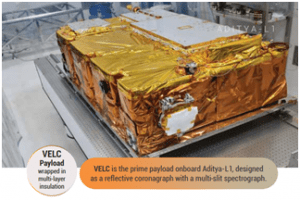
SOLAR ULTRAVIOLET IMAGING TELESCOPE (SUIT)
To image the Solar Photosphere and Chromosphere in near Ultra-violet (UV) and, to measure the solar irradiance variations in near UV.

ADITYA SOLAR X-RAY SPECTROMETER (SOLEXS)
To measure the X-ray spectrum of the solar corona and to study the coronal plasma.

HIGH ENERGY L1 ORBITING X-RAY SPECTROMETER (HEL1OS)
To study X-ray flares from the Sun over a wide energy X-Ray range. Sun as a star observation.
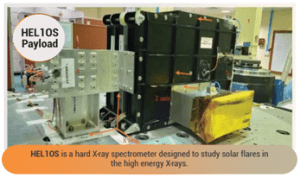
ADITYA SOLAR WIND PARTICLE EXPERIMENT (ASPEX)
It is designed to study the solar wind and energetic ions, as well as their energy distribution.

PLASMA ANALYSER PACKAGE FOR ADITA (PAPA)
It is designed to study the Solar wind. It acts as Particle Analyzer for Electrons and Heavier Ions with directions.
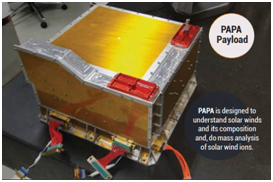
ADVANCED TRI-AXIAL HIGH RESOLUTION DIGITAL MAGNETOMETERS
To study the in-situ magnetic field (Bx, By and Bz). The Magnetometer is capable of measuring the interplanetary magnetic fields at L1 point.
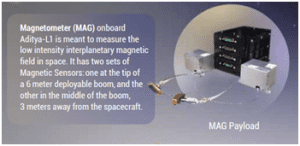
WHAT ARE THE OBJECTIVES OF ADITYA-L1 MISSION?
UNDERSTANDING THE SOLAR CORONA
Aditya-L1 aims to study the outermost layer of the Sun’s atmosphere, known as the corona. The corona is much hotter than the Sun’s surface, and understanding the mechanisms that heat it to millions of degrees Celsius is one of the key goals of the mission.
STUDYING SOLAR ACTIVITIES
The mission will observe and study various solar phenomena, including solar flares, coronal mass ejections (CMEs), and other solar activities. By doing so, it seeks to improve our understanding of the Sun’s behavior and its impact on space weather.
INVESTIGATING SOLAR MAGNETIC FIELDS
Aditya-L1 will measure the magnetic field of the Sun, providing valuable data on the Sun’s magnetic activity and variations. Understanding solar magnetic fields is crucial for studying solar cycles and their effects on space weather.
SPACE WEATHER IMPACT
The mission aims to better comprehend the influence of solar activities on space weather, including their potential effects on Earth’s ionosphere and magnetosphere. This information is essential for mitigating space weather-related disruptions to communication, navigation systems, and satellite operations.
CLIMATE STUDIES
Aditya-L1 is intends to investigate the link between solar activity and Earth’s climate. Understanding how variations in solar radiation impact our planet’s climate is an important aspect of the mission.
TECHNOLOGY DEMONSTRATION
The mission includes technology demonstrations to test and validate various instruments and systems that will be used for future space missions.
WHAT IS THE NEED AND SIGNIFICANCE OF ADITYA-L1 MISSION?
ADVANCING SOLAR SCIENCE
The mission aims to significantly enhance our understanding of the Sun, particularly its outermost layer, the corona, which is hotter than the Sun’s surface but not well-understood. This knowledge is crucial for advancing solar science and improving our comprehension of the fundamental processes that govern stars like the Sun.
SPACE WEATHER PREDICTION
Aditya-L1 will contribute valuable data for space weather prediction. Solar activities, such as solar flares and coronal mass ejections, can have a substantial impact on Earth’s space environment. Understanding these phenomena and their effects is essential for protecting satellites, spacecraft, and even power grids on Earth from potential disruptions caused by space weather events.
TECHNOLOGICAL BENEFITS
The mission includes technology demonstrations, which can lead to the development of advanced instruments and systems that can be used in future space missions. This technology transfer can benefit various sectors, including space exploration, communication, and Earth observation.
CLIMATE STUDIES
Aditya-L1’s investigation into the link between solar activity and Earth’s climate can provide insights into long-term climate variations. While it may not be the sole determinant of climate change on Earth, understanding the Sun’s role in influencing our climate is valuable for climate research.
SCIENTIFIC COLLABORATION
The mission involves international collaboration, which fosters cooperation in space science and technology. Sharing data and research findings with the global scientific community can lead to broader insights and discoveries.
EDUCATIONAL AND OUTREACH OPPORTUNITIES
The Aditya-L1 is interest in science and technology among students and the public. They provide educational opportunities and encourage STEM (Science, Technology, Engineering, and Mathematics) engagement, which can lead to a future generation of scientists and engineers.
SPACE LEADERSHIP
The successful execution of missions like Aditya-L1 enhances India’s position in space exploration and research. It demonstrates the country’s capabilities in space technology and its commitment to advancing scientific knowledge.
WHAT ARE LAGRANGIAN POINTS?
Lagrangian points, also known as Lagrange points or libration points, are specific positions in space where the gravitational forces of two large objects, such as the Earth and the Moon or the Earth and the Sun, produce enhanced regions of attraction and repulsion. These points were first described by the Italian-French mathematician Joseph-Louis Lagrange in 1772.
There are five Lagrangian points designated as L1, L2, L3, L4, and L5, each with unique properties:
- L1 (Lagrange Point 1): This point lies along the line connecting the two large bodies and is located on the side of the larger body (e.g., the Earth) closer to the smaller body (e.g., the Moon or the Sun). At L1, the gravitational pull of the two bodies effectively cancels out, creating a point of stability. Objects placed at this point can maintain a relatively fixed position relative to the smaller body (e.g., a satellite monitoring the Sun) or conduct observations without the need for excessive fuel for station-keeping.
- L2 (Lagrange Point 2): L2 is also along the line connecting the two large bodies but is located on the opposite side of the larger body from the smaller body. It is used for various purposes, including astronomical observations, space telescopes, and Earth-observing satellites. Objects placed at L2 can maintain a stable position relative to the Earth and Sun.
- L3 (Lagrange Point 3): L3 is directly opposite L1, along the line connecting the two large bodies. It is less commonly used than other Lagrange points due to its instability. However, it has been considered for future space missions and exploration.
- L4 and L5 (Lagrange Points 4 and 5): These points are located at equal distances from both large bodies, forming an equilateral triangle with the two large bodies. L4 leads the smaller body in its orbit, while L5 follows it. L4 and L5 are often used in the context of the Earth-Moon system for potential locations of spacecraft, satellites, or future lunar missions. They are particularly stable and have been explored for space missions related to asteroid detection and planetary exploration.
Lagrangian points are essential in space exploration and satellite positioning because they offer stable regions in space where objects can remain in relatively constant positions relative to the larger celestial bodies. They have been used for a variety of purposes, including astronomical observations, space science missions, and Earth monitoring, and they play a critical role in planning and executing space missions.
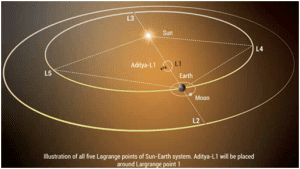
ADITYA L1’S JOURNEY FROM EARTH TO THE L1 LAGRANGE POINT
The journey of the Aditya-L1 mission from Earth to the L1 Lagrange Point involves several phases and complex orbital maneuvers. The following steps involved:
- Launch: The Aditya-L1 mission begins with its launch from Earth. The launch vehicle used would depend on the specific requirements and payload of the mission. Typically, ISRO would use one of its reliable rockets, such as the Polar Satellite Launch Vehicle (PSLV) or the Geosynchronous Satellite Launch Vehicle (GSLV), to launch Aditya-L1 into a transfer orbit.
- Transfer Orbit: After launch, Aditya-L1 enters a transfer orbit that takes it away from Earth and toward its destination, the L1 Lagrange Point. The transfer orbit is designed to conserve fuel while allowing the spacecraft to gradually increase its distance from Earth.
- Orbital Maneuvers: During its journey, Aditya-L1 performs a series of orbital maneuvers to adjust its trajectory and align itself with the L1 Lagrange Point. These maneuvers involve firing its onboard propulsion system at specific points along its trajectory to change its speed and direction.
- Earth-Sun Halo Orbit: To reach the L1 Lagrange Point, Aditya-L1 will ultimately enter a specific type of orbit known as an Earth-Sun Halo orbit. This orbit allows the spacecraft to remain in the vicinity of the L1 point while taking into account the gravitational influences of both the Earth and the Sun. It involves a delicate balance of forces to keep the spacecraft in a stable position relative to the L1 point.
- Arrival at L1: Once Aditya-L1 reaches the vicinity of the L1 Lagrange Point, it will perform precise orbital maneuvers to ensure it enters the L1 region and maintains a stable position there. At L1, the gravitational forces of the Earth and the Sun are roughly balanced, allowing the spacecraft to maintain its position with minimal fuel expenditure.
- Mission Operations: After reaching its destination, Aditya-L1 begins its scientific observations and data collection activities. It will study the Sun and perform various experiments and observations related to solar phenomena and space weather.
The journey to L1 and subsequent mission operations are carefully planned and executed to achieve the mission’s scientific objectives. Aditya-L1’s mission control team on Earth closely monitors the spacecraft’s status and conducts regular course corrections and adjustments as needed to ensure it reaches and maintains its position at the L1 Lagrange Point. Top of Form
SOLAR SPACE PROGRAM OF OTHER COUNTRIES
NASA’S SOLAR AND HELIOPHYSICS PROGRAMS (UNITED STATES)
NASA has a long history of solar and heliophysics missions. Notable missions include the Solar Dynamics Observatory (SDO), Parker Solar Probe, and the upcoming James Webb Space Telescope, which will also study the Sun and its interactions with the solar system.
ESA’S SOLAR MISSIONS (EUROPEAN SPACE AGENCY)
ESA has been involved in multiple solar missions, such as the Solar and Heliospheric Observatory (SOHO), Solar Orbiter, and the upcoming Lagrange mission to study the Sun’s polar regions.
JAPAN’S SOLAR MISSIONS (JAPAN AEROSPACE EXPLORATION AGENCY – JAXA)
JAXA has launched missions like Hinode (Solar-B) and the upcoming Solar-C mission, which aim to study the Sun’s magnetic fields and solar activity.
CHINA’S SOLAR MISSIONS (CHINA NATIONAL SPACE ADMINISTRATION – CNSA)
China has launched the Chang’e missions to the Moon, which also carried instruments to observe the Sun. Additionally, CNSA has plans for solar observation missions like the Solar Exploring Orbiter (SOLEX) and the Solar Wind Magnetosphere Ionosphere Link Explorer (SMILE).
INDIA’S ADITYA-L1 MISSION (INDIAN SPACE RESEARCH ORGANISATION – ISRO)
As previously discussed, ISRO launched the Aditya-L1 mission to study the Sun, particularly its corona and its impact on space weather.
RUSSIA’S SOLAR MISSIONS (ROSCOSMOS)
Russia has been involved in solar research and space weather monitoring through various missions and collaborations, such as the International Space Station (ISS) and the Interheliozond mission.
SOUTH KOREA’S SOLAR MISSIONS (KOREA ASTRONOMY AND SPACE SCIENCE INSTITUTE – KASI)
KASI has been involved in solar research and has plans for future solar observation missions.
THE CHALLENGES OF ADITYA-L1 MISSION
ORBITAL DYNAMICS
Aditya-L1 is designed to orbit the L1 Lagrange Point, which requires precise orbital calculations and maneuvers to maintain its position relative to the Earth and the Sun. The gravitational forces of these celestial bodies can affect the spacecraft’s trajectory, necessitating regular orbital adjustments.
INSTRUMENTATION
Aditya-L1 carries a suite of scientific instruments for solar observation. Developing and calibrating these instruments to capture accurate and detailed data about the Sun’s behavior and magnetic fields is a significant technical challenge.
DATA TRANSMISSION
Transmitting large amounts of data from the spacecraft to Earth poses a challenge, as it must be done efficiently and reliably. The distance between the L1 Lagrange Point and Earth can affect communication and data transfer rates.
SPACECRAFT OPERATIONS
Operating the spacecraft from Earth requires precise command sequences and regular monitoring to ensure it remains in its intended orbit and continues to collect valuable scientific data.
SOLAR FLARES AND SPACE WEATHER
The mission aims to study solar flares and their impact on space weather. However, solar flares can be unpredictable and pose a potential threat to the spacecraft’s instruments.
BUDGET AND FUNDING
Securing funding for space missions can be challenging. Ensuring a stable budget throughout the mission’s lifecycle is essential for its success.
WAY FORWARD
DATA ANALYSIS
The collected data will be analyzed by scientists and researchers to extract valuable insights into solar science and space weather. This analysis may lead to new discoveries and a deeper understanding of solar activity.
TECHNOLOGY DEMONSTRATION
Aditya-L1 includes technology demonstrations, and the successful validation of these technologies can lead to their broader use in future space missions.
CONTINUED SCIENTIFIC OBSERVATIONS
Aditya-L1’s primary mission objective is to study the Sun and its various phenomena, including the solar corona, solar flares, and magnetic fields. The spacecraft will continue to collect data and images to enhance our understanding of these aspects.
INTERNATIONAL COLLABORATION
Aditya-L1 is part of international efforts to study the Sun and space weather. Continued collaboration with other space agencies and organizations will ensure that data is shared and analyzed globally, leading to a more comprehensive understanding of solar phenomena.
MISSION UPDATES AND REPORTS
Regular mission updates and reports will be provided to the scientific community and the public to communicate the mission’s progress and findings.
DATA ARCHIVING
Ensuring the long-term availability and accessibility of mission data is essential for future research and scientific advancements.
PREPARATION FOR FUTURE MISSIONS
Lessons learned from Aditya-L1 can inform the planning and execution of future solar and space weather missions. India and other space agencies may continue to invest in solar science research.
CONCLUSION: The Aditya-L1 mission represents an important endeavor by the Indian Space Research Organisation (ISRO) to study the Sun and its various phenomena, including the solar corona, solar flares, and space weather. Its success will depend on the spacecraft’s launch, deployment, and its ability to carry out its scientific mission as planned. The Aditya-L1 mission are essential because they advance our knowledge of the Sun, its behavior, and its influence on space weather, climate, and the solar system. They play a vital role in ensuring the safety and functionality of our technological infrastructure in space and on Earth and contribute to scientific understanding and technological innovation.
UPSC PRACTICE QUESTION
Q. What are the main objectives of the Aditya-L1 Mission? Comment on the need for such a mission to India.
Q. Discuss the significance and challenges of the Aditya-L1 Mission. How does the Aditya-L1 Mission compare to previous missions studying the Sun?
PYQS RELATED TO ADITYA-L1 MISSION
Q. Discuss India’s achievements in the field of Space Science and Technology. How the application of this technology has helped India in its socio-economic development? (UPSC Mains 2016)
Q. If a major solar storm (solar-flare) reaches the Earth, which of the following are the possible effects on the Earth? (UPSC Prelims 2022)
- GPS and navigation systems could fail.
- Tsunamis could occur at equatorial regions.
- Power grids could be damaged.
- Intense auroras could occur over much of the Earth.
- Forest fires could take place over much of the planet.
- Orbits of the satellites could be disturbed.
- Shortwave radio communication of the aircraft flying over polar regions could be interrupted.
Select the correct answer using the code given below:
(a) 1, 2, 4 and 5 only
(b) 2, 3, 5, 6 and 7 only
(c) 1, 3, 4, 6 and 7 only
(d) 1, 2, 3,4, 5, 6 and 7
Answer: C
Q. With reference to ‘Astrosat’, the astronomical observatory launched by India, which of the following statement(s) is/are correct? (UPSC Prelims 2016)
- Other than USA and Russia, India is the only country to have launched a similar observatory into space.
- Astrosat is a 2000 kg satellite placed in an orbit at 1650 km above the surface of the Earth.
Select the correct answer using the codes given below.
(a) 1 only
(b) 2 only
(c) Both 1 and 2
(d) Neither 1 nor 2
Answer: D
Q. Which of the following pair(s) is/are correctly matched? (UPSC Prelims 2014)
Spacecraft Purpose
- Cassini-Huygens : Orbiting the Venus and transmitting data to the Earth
- Messenger : Mapping and investigating the Mercury
- Voyager 1 & 2 : Exploring the outer solar system
Select the correct answer using the codes given below.
(a) 1 only
(b) 2 and 3 only
(c) 1 and 3 only
(d) 1, 2 and 3
Answer (b)
Spread the Word
